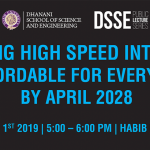The SSE Public Lecture Series kicked off this semester with a student-led talk and panel discussion, moderated by a student, Zuha Sohail, in which car-making teams from PNEC-NUST and Habib University sat together to relate the ups and downs and twists and turns in the journey to making their dream car.
The students also engaged in a mentorship session of sorts where the students of the PNEC-NUST team, who had already finished their car and won the Formula 1 Competition with their Electric Racing Car, talked to students of Habib University who were in the process of making their own fuel-efficient car. Continue reading →
Read More5th December 2019
Hasan Baig is an Assistant Professor in the Department of Electrical and Computer Engineering at Habib University in Karachi, Pakistan. He holds a PhD from the Denmark Technical University, where he worked on developing methods and tools for the analysis, verification, and synthesis of genetic logic circuits. He has previously worked in various industries in Pakistan, South Korea, and the United States as a Hardware and Design Engineer, specializing in system-on-chip development. He owns patents of the fault-tolerant FPGA architecture and has to his name, several published articles in reputable journals, conferences, and workshops.
In his session, Dr. Baig introduced the public lecture series audience to genetic engineering, specifically by discussing genetic circuits in comparison to electrical circuits. He broke down the idea of genetic circuit systems by first elaborating on the composition of programs that work through electrical systems. Programs are purposed so they can follow a set of command instructions as input and execute operations towards an output. Embedded systems as in smartphones are an example of electrical systems on a chip, designed to perform desired functions through the cell device. The phenomenon Dr. Baig brought to light was the possibility that electrical components in embedded system circuits could also be biological. Genetic engineering has been an area of research that has conceived programmable genetic systems, which include circuits comprising programmable DNA.
Dr. Baig gave a very basic overview of how a genetic circuit works by contrasting it with the electrical circuit. He pointed out that in the biotech field, embedded systems notably see application in pacemakers and chemotherapy, where high radiation aims to destroy harmful cells. However, it also causes other cells to be compromised, resulting in side effects like hair loss. In these cases, genetic systems may prove more efficient. Genetic circuits, though similar to electrical ones, have different inputs and outputs. For instance, in the treatment of defective cells if the circuit is satisfied in its multiple conditions of i) a living cell and ii) a defective cell, it can then as an output release a protein to destroy them. As opposed to electrical circuits, the genetic ones have DNA components, varying inputs and outputs depending on the type of protein, and high signal interference owing to molecule movement. It is of note that while we know the right conditions for electrical circuits, from the appropriate temperature to the type of component, it is difficult to determine in genetic circuits as its preconditions may vary depending on the scenario.
The design flow of genetic circuits requires more detailed specifications. Dr. Baig highlighted some tools that are helpful in this regard, for instance, genetic programming can be coded in a systems biology markup language called SPML 5. Much of his work comprised developing tools and programs to analyze different genetic models through simulations, optimization, and synthesis optimization technology mapping.
Working in virtual experimentation where models were tested through real-time interaction with its genetic systems, Dr. Baig helped implement an improved system. They designed a specialized laboratory environment for experimenting and observing genetic models as well as a tool, the Dynamic Virtual Analyzer and Simulator (DVA-Sim) that can generate virtual tools suitable to each genetic model. The DVA-Sim is an automated analysis and verification system that can check model functionality in varying parameters to determine the level of input it requires. So the threshold value or minimum concentration of a protein that is needed by a genetic model under changing conditions can be tested for through the DVA-Sim. Dr Baig reported he was able to apply the algorithm he made on 15 different models at the University of Utah and MIT. He named another one of their applications, the GeneTech is a technology mapping tool that along with the DVA-Sim is available for download online and has received an encouraging response. Combining the two tools in their functionalities is the next goal for Dr. Baig and his team.
Towards the end, he gave credit to all the collaborators who are making advanced technology like genetic circuits a more concrete reality. Along with biotechnologists and experts from institutions in South Korea and across the world, he also listed a group of Habib University students who have been assisting him in ambitious projects. Dr. Baig introduced a unique side of the advancing field of engineering that shows a lot of potential for changing how we live life and in effect, the world. If DNA can be programmed, then there are a lot more revolutionalizing technologies to be expected.









